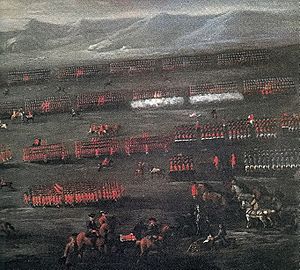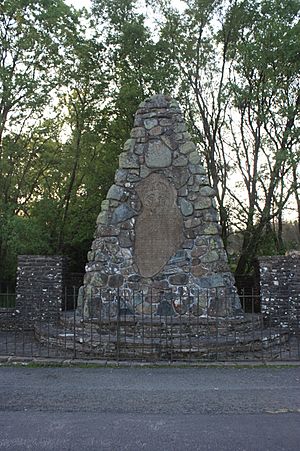Battle of Sheriffmuir facts for kids
Quick facts for kids Battle of Sheriffmuir |
|||||||
|---|---|---|---|---|---|---|---|
| Part of the Jacobite rising of 1715 | |||||||
 The Battle of Sheriffmuir, John Wootton |
|||||||
|
|||||||
| Belligerents | |||||||
| Commanders and leaders | |||||||
| Strength | |||||||
| 6,000 | 12,000 | ||||||
| Casualties and losses | |||||||
| 800 killed, wounded or captured | 232 killed, wounded or captured | ||||||
| Designated | 21 March 2011 | ||||||
| Reference no. | BTL17 | ||||||
The Battle of Sheriffmuir (Scottish Gaelic: Blàr Sliabh an t-Siorraim) was an important fight that happened in 1715. It was part of the Jacobite rising, a time when people in England and Scotland wanted to bring back the old royal family. The battle took place in a remote area called Sheriffmuir, which is a high, open piece of land between Stirling and Auchterarder in Scotland. This historic battlefield is now protected by Historic Scotland.
Contents
Why the Battle Happened
The Jacobite cause was about supporting James Francis Edward Stuart, also known as the "Old Pretender." He was the son of the last Stuart king, and his supporters wanted him to be the new king.
Leaders and Armies
John Erskine, 6th Earl of Mar, was a main leader for the Jacobites in Scotland. He gathered many Highland chiefs and their clans. On September 6, he announced that James Francis Edward Stuart was the rightful King of Scots. Mar's army grew to about 12,000 men. They took control of Perth and much of the northern Highlands.
The government forces were led by John Campbell, 2nd Duke of Argyll. He was based at Stirling. After some smaller fights, Mar decided to move his large army south on November 10. Argyll found out about Mar's plan. He quickly moved his army of about 4,000 soldiers to Sheriffmuir, close to Dunblane. The two armies met on the battlefield on November 13, 1715.
The Battle Itself
Argyll's army was much smaller than the Jacobite army. The Jacobites had about 12,000 soldiers, while Argyll had only 4,000.
Fighting on Both Sides
Argyll's right side attacked first and pushed the Highlanders back. However, Argyll's left side, led by General Thomas Whetham, was greatly outnumbered. They struggled against the much larger Jacobite force. Argyll quickly moved to help Whetham's soldiers.
By the end of the day, both armies had lost many soldiers. Even though Mar's army was much bigger, he chose not to risk all his men. This allowed Argyll to pull his troops back.
Who Won?
The battle ended without a clear winner. Both sides claimed they had won. However, in a bigger sense, Argyll had stopped the Jacobite army from moving forward. This was a key success for the government. The Jacobite army felt discouraged because they had more soldiers but didn't win decisively. Many of their supporters from France and Spain left after this battle.
What Happened Next
The Jacobite leader, the Earl of Mar, could have tried to join forces with other Jacobites in England. But he didn't seem to know how to plan a full military campaign. This was a big missed chance for the Jacobites.
The Pretender Arrives and Leaves
On December 23, the "Old Pretender," James Francis Edward Stuart, landed in Peterhead, Scotland. He had been living in France. By this time, his cause was mostly lost. He met with Mar in Perth but couldn't cheer up his discouraged army.
Argyll's army grew stronger and moved north. The Jacobite army fled to Montrose, and the Pretender went back to France. The remaining Jacobite soldiers moved to Ruthven and then broke up.
Jacobite Losses Elsewhere
This period was very bad for the Jacobite cause. Many of their supporters in the south were captured at the Battle of Preston. Also, Inverness and the surrounding areas were taken back by the government. This happened thanks to clans who supported the government, like the Earl of Sutherland, Fraser Lord Lovat, the Rosses, the Munros, and the Forbeses.
Battle Losses
The Jacobites lost about 800 men. Among those killed were John Lyon, 5th Earl of Strathmore and Kinghorne, and the chief of the Clan Ranald of Clan MacDonald. James Maule, 4th Earl of Panmure, and Drummond of Logie were wounded. Because of these losses, the Jacobite army had to retreat to Perth. Argyll believed he had won and even had a special medal made to celebrate.
The government army lost about 600 soldiers who were killed or wounded. Archibald Douglas, 2nd Earl of Forfar, was the only important person killed on their side.
A famous Jacobite song called "Sheriffmuir fight" was written about the battle. Like many songs from that time, it made the battle sound like a great victory for the Jacobites. The songwriter James Hogg collected or possibly wrote it in 1819.
Robert Burns and "The Battle of Sherramuir"
The Battle of Sheriffmuir was also the topic of a famous song by the poet Robert Burns. His song is called "The Battle of Sherramuir".
How Burns Wrote the Song
Burns wrote the song in 1787 when he was traveling through the Highlands. It was first printed in a book called the Scots Musical Museum in 1790. He wrote it to be sung to the tune of "Cameronian Rant".
Burns knew that the battle ended in such a way that no one was sure who really won. So, his poem tells the story from the point of view of two shepherds who have different ideas about what happened.
Two Different Views
One shepherd thinks that the "red-coat lads" (the government soldiers) completely defeated the rebels. He describes how they "hough the Clans like nine-pin kyles" (meaning they badly beat the clans).
The other shepherd is just as sure that the Jacobites "did pursue / The horsemen back to Forth, man." He believes the Jacobites chased the government soldiers, and "mony a huntit, poor Red-coat / For fear amaist did swarf, man" (meaning many scared soldiers almost fainted).
Burns was not happy with the first version of his poem. He rewrote it after 1790. This new version was published after he died by his editor, James Currie, in a book called The Complete Poetical Works of Robert Burns (1800).
Images for kids
See also
 In Spanish: Batalla de Sheriffmuir para niños
In Spanish: Batalla de Sheriffmuir para niños



